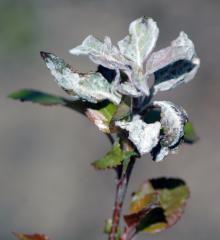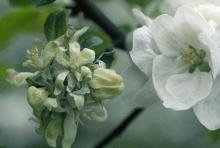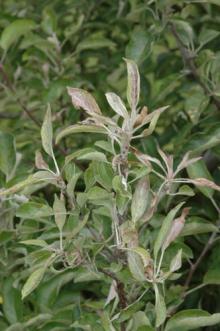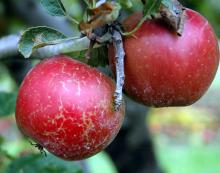See:
Cause Podosphaera leucotricha, a fungus that overwinters in terminal buds of apples. Temperatures less than 11°F will begin to kill fungal mycelia in these buds. Infected buds start to die at -11°F; however, healthy buds can survive even lower temperatures. Infected buds that survive winter open later than healthy buds in the spring. When infected shoots begin to grow they may already be covered with conidia that are quickly dispersed to healthy foliage. Spores may be easily dispersed between orchards up to 10 miles away and on occasion 60 miles away. Young shoots and leaves become infected, develops new colonies and new conidia that continue this cycle many times during the growing season. Conidia are generally inhibited by free water on leaf surfaces. Leaves are susceptible for only a few days after emerging. New terminal growth on apple trees is particularly susceptible. Once terminal growth ceases, new infections diminish rapidly. Fruit infection occurs during bloom stages.
Powdery mildew is a frequent problem throughout the Pacific Northwest. Losses are due to its chronic effect on tree vigor and yield in addition to poor fruit finish for highly susceptible cultivars. Very susceptible apple cultivars include Braeburn, Granny Smith, Gravenstein, Honeycrisp, Jonathan, Newtown, and Rome. Fruits of the cultivars Jonathan and Rome also may be severely affected. Less susceptible apple cultivars: Fuji, Golden Delicious, Red Delicious, and Delicious strains. Pear orchards are at a higher risk of disease development if planted next to apple orchards. Other hosts include crabapple and quince.
Symptoms The disease occurs on foliage, twigs, blossoms, and fruit. Small gray or white felt-like patches of mycelia develop, frequently on the undersides of leaves. Young infected leaves increase in length but not in width, and become curled and distorted. Infected foliage is brittle and may be killed or cease to function normally, thus weakening the tree. The fungus often covers entire terminal shoots with its masses of white mycelium and powdery spores. Severely diseased terminal shoots are stunted with shortened internodes and are easily seen throughout the growing season and may persist into the dormant season. Diseased blossoms are brownish and shriveled and soon die. When fruits are infected, a network of lines, generally referred to as russeting, develops on the skin in the diseased area.
Cultural control
- Plant resistant cultivars such as Enterprise or Pristine, which have both powdery mildew and scab resistance. 'Fuji', 'Golden Delicious', 'Red Delicious', and 'Delicious' strains are not as susceptible as others cultivars.
- If practical, remove infected terminal shoots during dormant season pruning.
- Removal of the upper two-thirds of every shoot during dormant season pruning was shown to reduce disease. (Not practical for tip-bearing apples.)
- Home gardeners may find it useful to prune out and destroy infected shoots as they appear early in the year, but that is ineffective when the disease is severe.
- Follow cultural practices that promote good air circulation, such as pruning, and moderate shoot growth through judicious nitrogen management.
Chemical control Apply fungicides at prepink, pink, calyx, and first cover. The best timing of FRAC 3 fungicides was found to be between petal fall and first cover in New York. To limit infection of next year's buds, continue applications until terminal growth ceases. Alternate or tank-mix fungicides from different groups that have different modes of action. Limit applications from any particular group to two (2) or fewer per year. Selection of products for rotation and/or mixing must consider FRAC group 7 fungicides if used through the irrigation as a nematicide.
- Aprovia at 5.5 to 7 fl oz/A plus an adjuvant. Do not use within 30 days of harvest. Group 7 fungicide. 12-hr reentry.
- Axios 20 SC at 2.25 to 3 fl oz/A. Do not use within 7 days of harvest. Group 52 fungicide. 4-hr reentry.
- Bicarbonate-based products. Might be used to supplement a normal program when powdery mildew is first observed. More effective when combined with cultural controls. Do not mix with acidifying agents. Thorough coverage is essential. Poor to moderate control alone. O
- Kaligreen (82% potassium bicarbonate) at 2.5 to 3 lb/A. 4-hr reentry.
- MilStop (85% potassium bicarbonate) at 2.5 to 5 lb/A. Oregon and Washington only. 1-hr reentry.
- Monterey Bi-Carb Old Fashioned Fungicide at 4 teaspoons/2 gal water. H
- Cevya at 5 fl oz/A. Can be used on day of harvest. Group 3 fungicide. 12-hr reentry.
- Cinnerate at 16 to 64 fl oz/100 gal water plus an adjuvant. Can be used on day of harvest. No reentry listed. O
- Eagle 20 EW at 4 to 6 fl oz/100 gal water for home orchards or landscape use. Do not apply within 14 days of harvest. Do not use on pear. Group 3 fungicide. 24-hr reentry
- EcoSwing at 1.5 to 2 pints/A. Can be used day of harvest. Group BM01 fungicide. 4-hr reentry. O
- Excalia at 3 to 4 fl oz/A plus a non-oil-based adjuvant. Do not use past petal fall. Group 7 fungicide. 12-hr reentry.
- Flint Extra at 2.5 to 2.9 fl oz/A. Do not use within 14 days of harvest. Injury may occur to Concord grapes if accidentally sprayed. Group 11 fungicide. 12-hr reentry.
- Fontelis at 16 to 20 fl oz/A. Do not mix with thinning agents or use within 28 days of harvest. Group 7 fungicide. 12-hr reentry.
- Gatten at 6 to 8 fl oz/A. Do not use within 14 days of harvest. Use caution near pears as Gatten may be phytotoxic. Group U13 fungicide. 12-hr reentry.
- Horticultural Mineral Oils (HMO). Generally effective from 1% to 2% volume to volume. Necrotic foliage may result if applied within 10 days of any sulfur application. Do not tank-mix with copper-based products when fruit is present. Do not use during freezing temperatures, above 90°F, or when plants are under heat or moisture stress. Do not use when foliage is wet because good coverage is essential. 4-hr reentry. O
- JMS Stylet Oil at 1 to 2 gal/100 gal water.
- SuffOil-X at 1 to 2 gal/100 gal water.
- Indar 2F at 6 to 8 fl oz/A plus a wetting agent. Do not use within 14 days of harvest. Group 3 fungicide. 12-hr reentry.
- Inspire Super at 12 fl oz/A. Do not apply within 14 days of harvest. Group 3 + 9 fungicide. 12-hr reentry.
- Luna Sensation at 5 to 5.8 fl oz/A. Do not use within 14 days of harvest. Group 7 + 11 fungicide. 12-hr reentry.
- Luna Tranquility at 11.2 to 16 fl oz/A. Do not use within 72 days of harvest. Group 7 + 9 fungicide. 12-hr reentry.
- Merivon at 4 to 5.5 fl oz/A. Do not use with EC or oil-based products. May be used day of harvest. Group 7 + 11 fungicide. 12-hr reentry.
- Miravis at 3.4 fl oz/A. Do not use within 30 days of harvest. Group 7 fungicide. 12-hr reentry.
- Myclotect at 4 to 6 fl oz/100 gal water plus spreading agent. May observe a PGR effect. Do not use within 14 days of harvest. Group 3 fungicide. 24-hr reentry.
- Oso SC at 6.5 to 13 fl oz/A. May be applied on the day of harvest. Group 19 fungicide. 4-hr reentry. O
- Ph-D WDG at 6.2 oz/A. May be applied on the day of harvest. Group 19 fungicide. 4-hr reentry.
- Problad Verde at 18.1 to 45.7 fl oz/A. Needs 8 to 12 hours dry time to absorb into treated tissue. Do not use within one day of harvest. Group BM01 fungicide. 4-hr reentry.
- Pristine at 14.5 to 18.5 oz/A. The addition of a silicone-based surfactant has improved control. Can be used day of harvest. Group 7 + 11 fungicide. 12-hr reentry.
- Procure 480 SC at 8 to 16 fl oz/A. Do not apply within 14 days of harvest. Group 3 fungicide. 12-hr reentry.
- Rally 40 WSP at 5 to 10 oz/A depending on tree size. Growers have noticed less control at the 5 oz/A rate than they have achieved in the past. Use higher rates and mix with fungicides from other chemical groups. Do not apply within 14 days of harvest. Do not use on pear. Group 3 fungicide. 24-hr reentry.
- Regalia at 2 to 4 quarts/A but use 1 to 2 quarts/A during bloom. Use on 7-day intervals. May be used day of harvest. Does not benefit from the addition of an adjuvant. Group P5 fungicide. 4-hr reentry. O
- Rex Lime Sulfur Solution (28%) at 2 gal/100 gal water through bloom then 0.5 gal/100 gal water for petal fall and cover sprays. Can be used day of harvest. May injure fruit on 'Delicious' apples and is not for use on 'Ginger Gold'. 48-hr reentry. O
- Rhyme at 4 to 6 fl oz/A. Can be used through a drip or microsprinkler system at higher rate. Do not use within 14 days of harvest. May cause injury to leaves of Braeburn. Group 3 fungicide. 12-hr reentry.
- Romeo at 0.23 to 0.91 lb/A. Avoid hot days and reapply after strong rains. May be used day of harvest. Unknown efficacy in the PNW. 4-hr reentry. O
- Sil-Matrix at 1 to 4 quarts/100 gal water plus a nonionic surfactant. Can be applied up to the day of harvest. 4-hr reentry. O
- Sovran at 4 to 6.4 oz/A. Do not use within 30 days of harvest. Injury may occur to some sweet cherries, such as 'Van', if accidentally sprayed. Group 11 fungicide. 12-hr reentry.
- Spectracide Immunox Multi-Purpose Fungicide Spray Concentrate for Gardens at 0.67 fl oz/gal water. Do not use within 2 weeks of harvest. Do not apply more than 10 times per season. Group 3 fungicide. H
- Sulfur-based products. Do not apply in hot weather (more than 80°F) because sulfurs can russet fruit. Do not apply within 2 weeks of an oil spray. Group M2 fungicides. 24-hr reentry. O
- Microthiol Disperss (80% sulfur) at 10 to 20 lb/A. Do not use a spreader-sticker.
- Safer Brand Garden Fungicide (12% sulfur) at 2 fl oz/gal water thoroughly sprayed over the entire plant. H
- Thiolux (80% sulfur) at 10 to 20 lb/A.
- Tebucon 45 DF at 4 to 8 oz/A. Do not use within 75 days of harvest. Group 3 fungicides. 5-day reentry.
- Tesaris at 3.5 to 4.5 fl oz/A. Do not use with oil-based products. May be used day of harvest. Group 7 fungicide. 12-hr reentry.
- Topguard SC at 8 to 12 fl oz/A. Do not use within 14 days of harvest. May cause injury to leaves of Braeburn. Group 3 fungicide. 12-hr reentry.
- Topsin 4.5 FL at 15 to 20 fl oz/A plus another fungicide. Do not use within 1 day of harvest. Do not use at any time in the orchard if your packing house uses a FRAC 1 fungicide (such as Mertect or Decco Salt 19) postharvest. Group 1 fungicide. 2-day reentry.
- Torino at 6.8 oz/A. Only one application allowed per year. Do not use within 14 days of harvest. Group U6 fungicide. 4-hr reentry.
- Trionic 4 SC at 8 to 16 fl oz/A. Do not apply within 14 days of harvest. Group 3 fungicide. 12-hr reentry.
- Vacciplant at 14 to 60 fl oz/A plus an effective fungicide. Can be used day of harvest. Unknown efficacy in the PNW. Group P4 fungicide. 4-hr reentry.
Note: Some registered products offer only suppression of this disease and thus are not recommended for use. These products include Kenja and Magister.
Biological control Integrate with cultural control tactics. Apply at prepink, pink, calyx, and first cover but use at 7- to 10-day intervals, which may result in more applications during cool seasons.
- Aviv (Bacillus subtilis strain IAB/BS03) at 10 to 30 fl oz/100 gal water. Unknown efficacy. Preharvest interval not specified. 4-hr reentry. O
- DoubleNickel 55 (Bacillus amyloliquefaciens strain D747) at 0.25 to 3 lb/A. Can be used day of harvest. Unknown efficacy. Group BM02 fungicide. 4-hr reentry. O
- Serenade OPTI (Bacillus subtilis strain QST 713) at 14 to 20 oz/A. Active ingredient is a small protein. Can be used day of harvest. Variable efficacy in western Oregon. 4-hr reentry. O
- Serenade Garden Disease Control Concentrate at 2 to 4 fl oz/gal water. Variable efficacy in western Oregon. H O
- Sonata (Bacillus pumilis strain QST 2808) at 2 to 4 quarts/A plus an adjuvant. May be applied up to and including the day of harvest. 4-hr reentry. O
- Theia (Bacillus subtilis strain AFS032321) at 1.5 to 5 lb/A. May be applied up to and including the day of harvest. 4-hr reentry. O
Reference Holb, I.J., and Kunz, S. 2016. Integrated control of apple scab and powdery mildew in an organic apple orchard by combining potassium carbonates with wettable sulfur, pruning and cultivar susceptibility. Plant Disease 100:1894-1905.
Strickland, D. A., Ayer, K. M., Olmstead, D. L. and Cox, K. D. 2023. Refining Management of Apple Powdery Mildew in New York State with Weather-Based Fungicide Application Timing Programs. Plant Disease, 107:1425-1432






